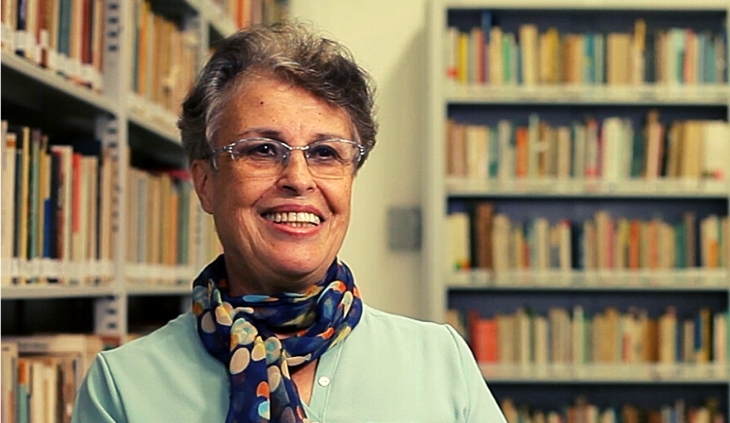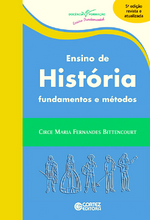History Teaching: foundations and methods | Circe Maria Fernandes Bittencourt
Resenhado por Itamar Freitas (UFS) | ID Orcid: https://orcid.org/0000-0002-0605-7214.

Circe Bittencourt | Imagem: BM Comunicação
Reviewed by Itamar Freitas and Margarida Maria Dias de Oliveira
Ensino de História: fundamentos e métodos (History Teaching: foundations and methods), written by Circe Bittencourt, is a book that deals with the teaching activity in basic education from the historical, epistemological and methodological points of view (History and Pedagogy). Its fifth edition was launched in 2018 and retains the same objective as in 2004: to support the initial and continuing education of teachers in basic education, as well as lectures in higher education, who train future graduates in History.
 The book has been a success since its first edition. On the website Resenha Crítica, the evaluation of the work is the most consulted post in 2021, among the approximately 4,000 available. There are, on average, 50 weekly accesses (Bueno; Urban, 2019). On Google Scholar, the fifth edition has already exceeded the mark of 2000 citations. It is a shame that after so many business, political and academic gains, the latest version, published in 2018, comes to public with the same imperfections detected more than a decade ago.
The book has been a success since its first edition. On the website Resenha Crítica, the evaluation of the work is the most consulted post in 2021, among the approximately 4,000 available. There are, on average, 50 weekly accesses (Bueno; Urban, 2019). On Google Scholar, the fifth edition has already exceeded the mark of 2000 citations. It is a shame that after so many business, political and academic gains, the latest version, published in 2018, comes to public with the same imperfections detected more than a decade ago.
To our luck, Bittencourt revealed the weakest parts of the work in a recent interview to Diogo Roiz: the insufficient discussion about the experience of history teaching in the early years of elementary school, the emphasis on the defense of thematic history as an alternative and, consequently, the abandonment of the other variables of substantive content (p.20-22).
Bittencourt also explained production context of the work. It was, in 2004, an editorial demand of Editora Cortez, interested in the alignment of publications of the genre with the new Law of Directives and Bases of National Education (1996). “The work had as its axis the Program of the course of Methodology of History Teaching in FEUSP, plus issues related to the teaching of history for the early grades” (Bittencourt, 2020, p.20-22)
The admitted shortcomings, however, were not communicated in the second, third, fourth and fifth editions. Ideally, a presentation should be appended to each edition released, informing about eventual changes of routes in the domains of History Teaching in the country.
There are few and clear-cut repairs. In part 1 (chapter 2), the text deserves a few lines to inform about the progress of research on the subject. Since 2009, the number of theses and dissertations, articles, communications and collection books must have exceeded hundreds. Some of these pieces have already dethroned, directly or indirectly, the theses of the invention of the domain supposedly occurred in the 80s of the last century and, likewise, the predominance of the experience of Rio de Janeiro and São Paulo as substantive content for a history of history teaching in Brazil.
Chapter three demonstrates and proves this misunderstanding. Dealing with history in the “current curriculum proposals”, the author revised the references to the 1980s, inserted qualifiers and text blocks, adding a few paragraphs on the debates around the Common National Curricular Base (BNCC), on the project “School without Party”, and the unfoldings of the BNCC in high school. The author also wrote a topic entirely dedicated to the inclusion of the theme “social and cultural diversity” in the curricula. What is the reason for the special treatment? Was there political-academic interest in keeping the ground thesis while commercial interest in changing the information regarding the curriculum?
At the beginning of the second part, there is maintenance of a position that is strongly contested in studies that map and delimit research on history teaching as academic domain. The author states that “Basic point for the establishment of a criterion for the selection of contents is the conception of history” (BITTENCOURT, 2018, p.125). We think it is necessary to add (before or after the topic) the following contextualization: “from the perspective of history graduates who have never experienced basic education”, the conception of history is the basic point. We think (along with one of the main contributions employed by the author herself – André Chervel) that the “basic point” are the purposes of history teaching. Who prescribes them: the teacher, the State, the market or the family? And when the purposes already presuppose a speculative philosophy of history and an epistemology of history, what should the teacher do with these prescriptions?
Consistent with her perspective, the author exposes “some of the historiographical trends” related to “school production” (narrative, economic, social, cultural, and of the present time). She states that the “narrative history” is associated with Ranke, which “came to be called historicism”, generating a “methodology known as positivist”, whose practitioners “dedicated themselves to the study of the irreproducible and unique individuality, highlighting figures of the elites and their biographies” etc. Thus, a single character and rubric condensed all the supposed evils present in history teaching, past and present, in German states and in the corners of Brazil, without distinction: emphasis on the political, individualism, elitism, neutrality and objectivity. This position (though not invented by Bittencourt) is bad for the teacher’s education. It does not make critically known the history of historiography and provides a (false) path for those who want to identify the principle of bad teaching without any cognitive and ethical effort.
The election of the “basic point” causes vagueness in the following chapter. If the guiding principle “is the conception of history,” why do historians by profession not contribute ideas about historical learning? Is the author suggesting that historians come in with the substantive content while psychologists bring the learning theory?
In the third chapter, the problem is one of definition. The author does not state her understanding of “method”, although she categorically uses the expressions “traditional methods” and “conservative methods”. We think that “traditional” is coined within a given communicative situation. It is defined in the midst of the teacher’s initial training, the immediate demands of the school, the material resources inside the classroom and, above all, the prescribed or implicit purposes of the history curriculum component in a given context. This principle renders ineffective the characterization of the traditional as authoritarian, expository, narrative and political. How many of us would be left in the classroom if such a classification were to become law? Should we then conclude that – considering the majority work context of teachers in basic education – elements of this traditional are, after all, in certain situations, virtues of the contemporary professional?
This conceptual problem is repeated in part three, when the author treats the textbook as “a complex cultural object”. The problem here is the refusal to define. The textbook (or any other object) is not something “difficult to define”. It is enough to choose the criteria – it is what the author does then, implicitly, by mentioning the “familiarity of use”. Just ahead in the text, unfortunately, she goes back to the difficulty, presenting different ways in which the artifact can be addressed in and beyond the classroom: “cultural product”, “support of knowledge”, “support of pedagogical methods”, “vehicle of a value system” etc. (p.301-302).
In the second chapter of part three, we identify a divergence of principle. The author reproduces the common sense phrase that the teacher cannot use documents in the classroom to form a “little historian”. She justifies the thesis with the differentiation of purposes of use (for the student of basic education and for the teacher). This is a mistake. The purposes of use, reflected on the basis of principles, are identical. In employing procedures of source criticism, historian and an early years students are mobilizing/developing/conserving/enhancing mental skills brought together in the expression that cuts across different conceptions of historical learning: “thinking historically”. Luckily, on behalf of good training, the author contradicts herself on the next page when suggesting the procedures employed by Adalberto Marson (BITTENCOURT, 2018, p.301-302).
In the last chapter of the book, the absence of historian principle is also the loose end. We argue that history teachers should not copy uncritically the procedures of specialists in, for example, material culture and audiovisual culture. We make little progress in history teaching when we import half-hearted procedures from principles of historical science suitable for training people. The actions of museologists and filmmakers, for example, in representing the past are of no value if they are not framed by a basic principle (also, for example) of the nineteenth century: statements about the past should be uttered only if in basis of sources that have been critiqued in a historiographical community. With this, we want to reiterate that history teaching cannot be a collection of methodologies of Heritage Education, of Film Analysis or of Musealization practices, alienated, for instance, from the principle that the historian statement must be supported by refutable evidence.
An appreciation of the work, as we have done here, is not an invitation to exclude it from the specialized bibliographies. It is a harm reduction initiative, carried out by people who read, know, and (most importantly) publicly manifest their love for knowledge of reference and action. We are convinced that students’ choices are mediated by various feelings. If they are passionate about Foundations and Methods, as we are passionate about Karl Marx’s German Ideology, for example, if they make every effort to cite it to where there is no need or where they could use a more substantive bibliography, we should contribute to the improvement of this tool. That is our intention.
If the publishers also wish to manifest their love to knowledge, without losing a penny in the profits earned from sales, they will certainly provide a preface or an afterword for the imminent sixth edition, providing updated bibliography in the form of appendices, alerting old and new readers to the dated and updated passages of this monumental work, and appending the author’s recently published self-critique.
References
Bittencourt Circe Maria Fernandes. Ensino de História: fundamentos e métodos. 5ed. São Paulo: Cortez, 2018. Review by: BUENO, Dioury de Andrade; URBAN, Ana Claudia. Revista de Educação Histórica, Curitiba, n. 19, p.83-87, jul./dez., 2019. Link
Roiz, Diogo da Silva. Interview with Circe Bittencourt. Educação: Teoria e Prática. Rio Claro, v.30, n.63, p.1-25, jun. 2020. Link
Summary of the reviewed work
Introduction
Part I. School history: profile of a discipline
- What is school discipline?
- Contents and methods of History Teaching: brief historical approach
- History in the current curriculum proposals
Part II. Methods and school contents: a necessary relationship
- Historical contents: how to select?
- Learning in History
- Methodological procedures in History Teaching
- Methodological procedures in interdisciplinary practices
Part III. Teaching materials: conceptions and uses
- History textbooks and teaching materials
- Didactic uses of documents
- Unwritten documents in the classroom
Reviewers
 Itamar Freitas – PhD in History (UFRGS) and in Education (PUC-SP), Professor of the Department of Education and of the Professional Masters in History of the Federal University of Sergipe, and editor of the blog Resenha Crítica. He published, among other works, Uma introdução ao método histórico (2021) and “Objetividade histórica no Manual de Teoria da História de Roberto Piragibe da Fonseca (1903-1986)”. Email: [email protected].
Itamar Freitas – PhD in History (UFRGS) and in Education (PUC-SP), Professor of the Department of Education and of the Professional Masters in History of the Federal University of Sergipe, and editor of the blog Resenha Crítica. He published, among other works, Uma introdução ao método histórico (2021) and “Objetividade histórica no Manual de Teoria da História de Roberto Piragibe da Fonseca (1903-1986)”. Email: [email protected].
 Margarida Maria Dias de Oliveira – PhD in History by the Federal University of Pernambuco (UFPE), Professor of the Department and Graduate Program in History at UFRN. She published, among other works, Dicionário do Ensino de História (2020), co-authored with Marieta e Morais Ferreira, and Formação dos professores de História: os desafios de uma profissão em processo de reinvenção. E-mail: [email protected].
Margarida Maria Dias de Oliveira – PhD in History by the Federal University of Pernambuco (UFPE), Professor of the Department and Graduate Program in History at UFRN. She published, among other works, Dicionário do Ensino de História (2020), co-authored with Marieta e Morais Ferreira, and Formação dos professores de História: os desafios de uma profissão em processo de reinvenção. E-mail: [email protected].
To quote this review
Bittencourt, Circe Maria Fernandes. Ensino de Hist¢ria: fundamentos e métodos 5 ed. 354p. E-book. Decolonizing the Teaching of History. Review by: Freitas, Itamar; Oliveira, Margarida Maria Dias de. Crítica Historiográfica. Natal, v.2, n.3, jan./feb. 2021.
Other reviews about History Teaching: foundations and methods
Dioury de Andrade Bueno and Ana Claudia Urban – Revista de Educação Histórica (2019)








